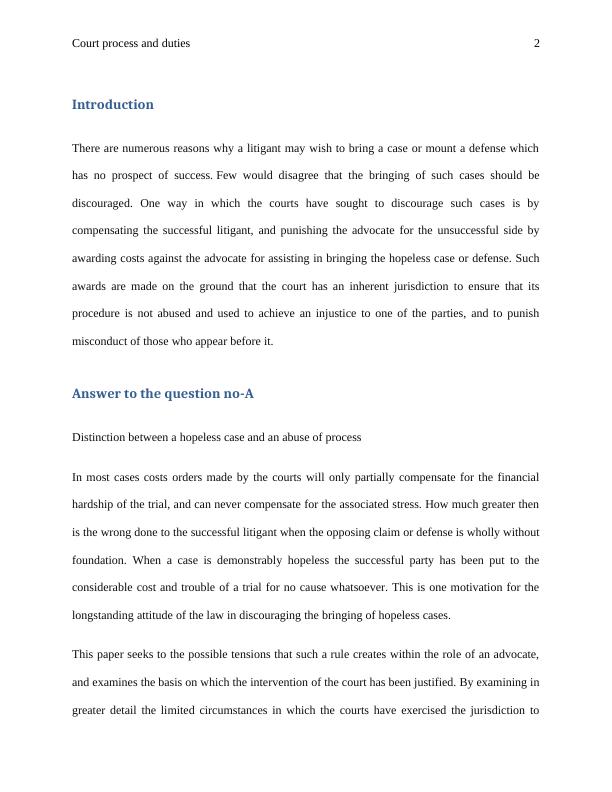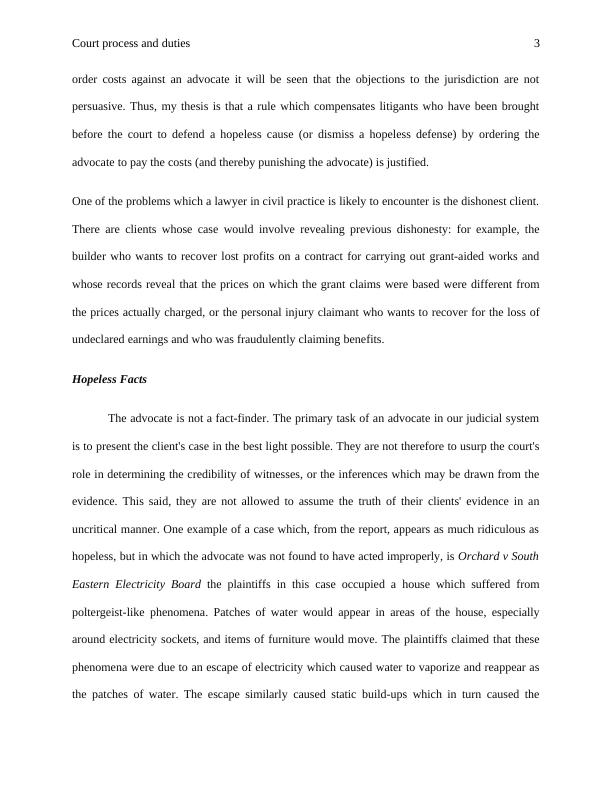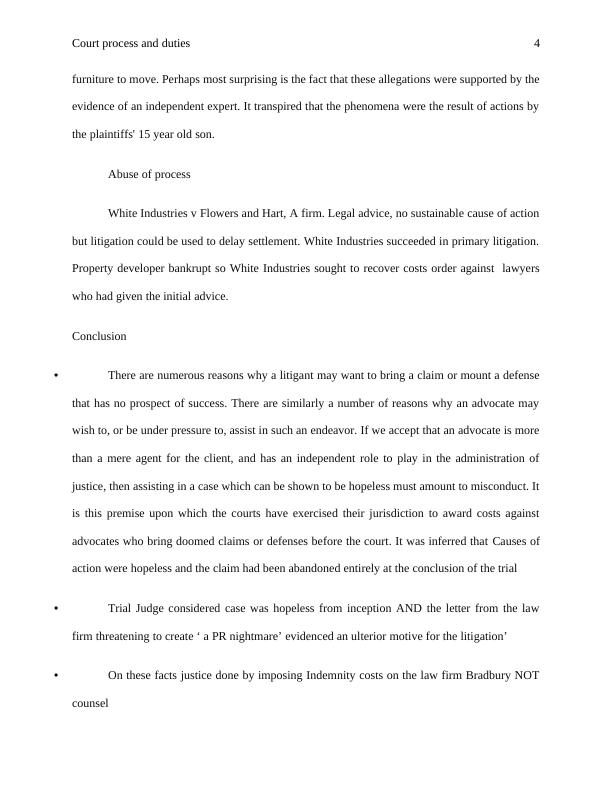Ask a question from expert
Report on Court Process and Duties
11 Pages2061 Words223 Views
Added on 2020-05-04
Report on Court Process and Duties
Added on 2020-05-04
BookmarkShareRelated Documents
RUNNING HEAD: Court process and duties1Case Study

Court process and duties2Introduction There are numerous reasons why a litigant may wish to bring a case or mount a defense whichhas no prospect of success.Few would disagree that the bringing of such cases should bediscouraged. One way in which the courts have sought to discourage such cases is bycompensating the successful litigant, and punishing the advocate for the unsuccessful side byawarding costs against the advocate for assisting in bringing the hopeless case or defense. Suchawards are made on the ground that the court has an inherent jurisdiction to ensure that itsprocedure is not abused and used to achieve an injustice to one of the parties, and to punishmisconduct of those who appear before it.Answer to the question no-ADistinction between a hopeless case and an abuse of processIn most cases costs orders made by the courts will only partially compensate for the financialhardship of the trial, and can never compensate for the associated stress. How much greater thenis the wrong done to the successful litigant when the opposing claim or defense is wholly withoutfoundation. When a case is demonstrably hopeless the successful party has been put to theconsiderable cost and trouble of a trial for no cause whatsoever. This is one motivation for thelongstanding attitude of the law in discouraging the bringing of hopeless cases. This paper seeks to the possible tensions that such a rule creates within the role of an advocate,and examines the basis on which the intervention of the court has been justified. By examining ingreater detail the limited circumstances in which the courts have exercised the jurisdiction to

Court process and duties3order costs against an advocate it will be seen that the objections to the jurisdiction are notpersuasive. Thus, my thesis is that a rule which compensates litigants who have been broughtbefore the court to defend a hopeless cause (or dismiss a hopeless defense) by ordering theadvocate to pay the costs (and thereby punishing the advocate) is justified. One of the problems which a lawyer in civil practice is likely to encounter is the dishonest client.There are clients whose case would involve revealing previous dishonesty: for example, thebuilder who wants to recover lost profits on a contract for carrying out grant-aided works andwhose records reveal that the prices on which the grant claims were based were different fromthe prices actually charged, or the personal injury claimant who wants to recover for the loss ofundeclared earnings and who was fraudulently claiming benefits.Hopeless FactsThe advocate is not a fact-finder. The primary task of an advocate in our judicial systemis to present the client's case in the best light possible. They are not therefore to usurp the court'srole in determining the credibility of witnesses, or the inferences which may be drawn from theevidence. This said, they are not allowed to assume the truth of their clients' evidence in anuncritical manner. One example of a case which, from the report, appears as much ridiculous ashopeless, but in which the advocate was not found to have acted improperly, isOrchard v SouthEastern Electricity Board the plaintiffs in this case occupied a house which suffered frompoltergeist-like phenomena. Patches of water would appear in areas of the house, especiallyaround electricity sockets, and items of furniture would move. The plaintiffs claimed that thesephenomena were due to an escape of electricity which caused water to vaporize and reappear asthe patches of water. The escape similarly caused static build-ups which in turn caused the

Court process and duties4furniture to move. Perhaps most surprising is the fact that these allegations were supported by theevidence of an independent expert. It transpired that the phenomena were the result of actions bythe plaintiffs' 15 year old son.Abuse of processWhite Industries v Flowers and Hart, A firm. Legal advice, no sustainable cause of actionbut litigation could be used to delay settlement. White Industries succeeded in primary litigation.Property developer bankrupt so White Industries sought to recover costs order against lawyerswho had given the initial advice.Conclusion•There are numerous reasons why a litigant may want to bring a claim or mount a defensethat has no prospect of success. There are similarly a number of reasons why an advocate maywish to, or be under pressure to, assist in such an endeavor. If we accept that an advocate is morethan a mere agent for the client, and has an independent role to play in the administration ofjustice, then assisting in a case which can be shown to be hopeless must amount to misconduct. Itis this premise upon which the courts have exercised their jurisdiction to award costs againstadvocates who bring doomed claims or defenses before the court. It was inferred that Causes ofaction were hopeless and the claim had been abandoned entirely at the conclusion of the trial•Trial Judge considered case was hopeless from inception AND the letter from the lawfirm threatening to create ‘ a PR nightmare’ evidenced an ulterior motive for the litigation’•On these facts justice done by imposing Indemnity costs on the law firm Bradbury NOTcounsel

End of preview
Want to access all the pages? Upload your documents or become a member.
Related Documents
Legal Process Assignmentlg...
|9
|1512
|242